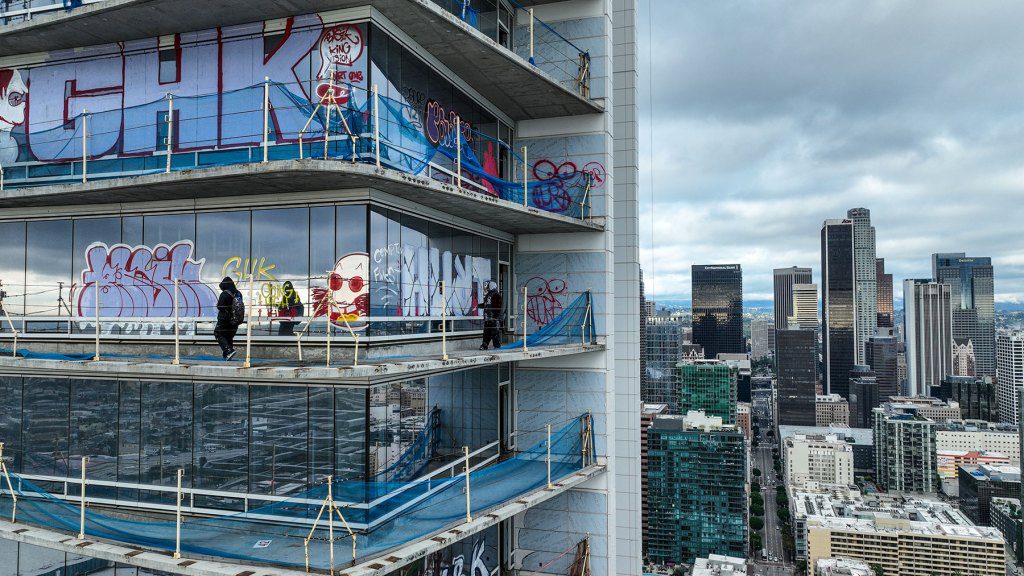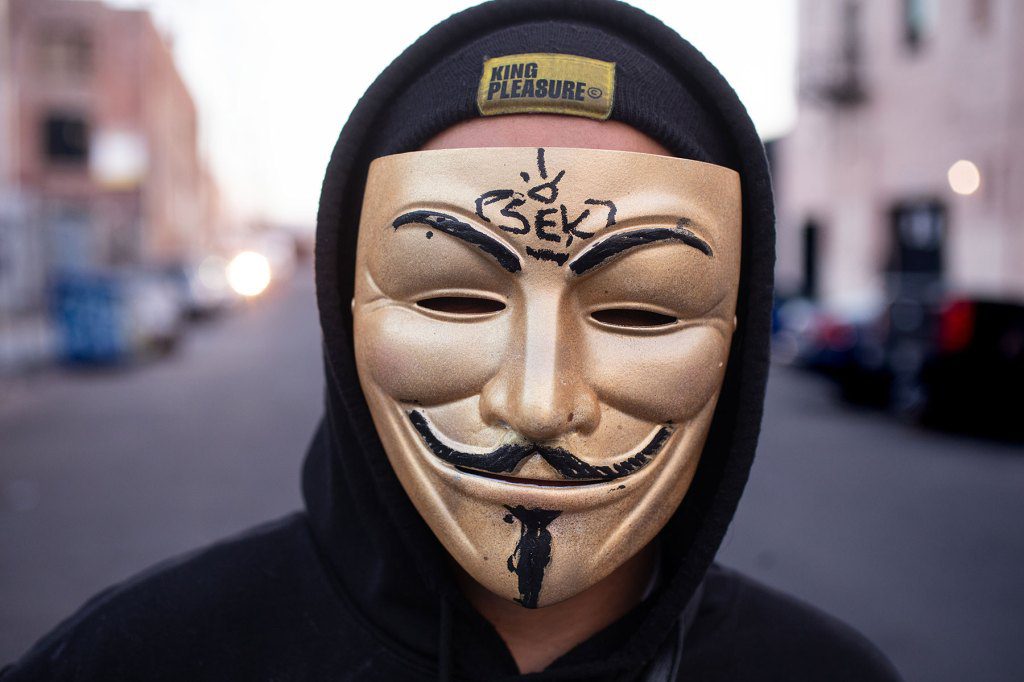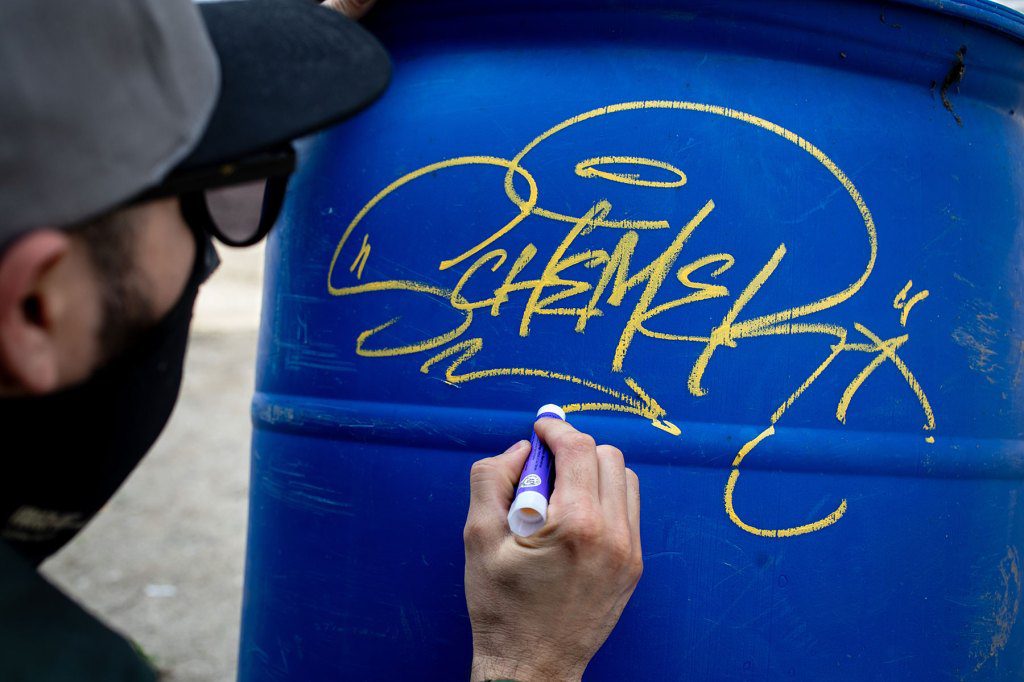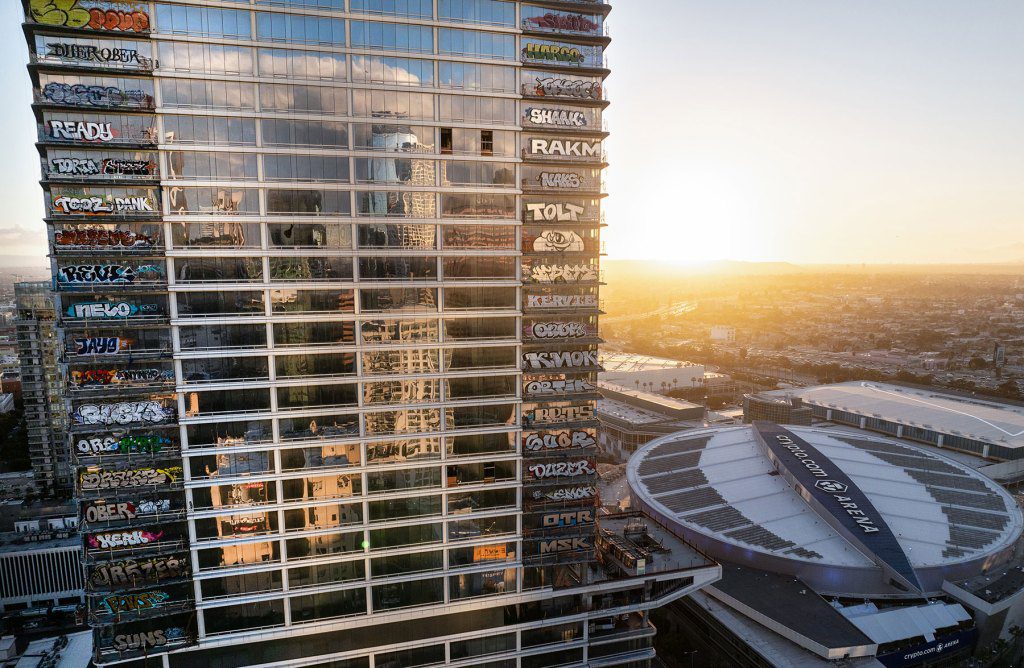‘Poetic Use of a Failed Space:’ Meet the Graffiti Artists Using Abandoned L.A. High-Rises as Their Canvas
This article was produced by Capital & Main. It is co-published by Rolling Stone with permission.
Not everyone made it to the top floors of Oceanwide Plaza — the abandoned billion-dollar development of luxury high-rises in downtown Los Angeles — but the graffiti artist called SEK was determined to get there. Dressed in his usual hoodie, and with a paint-splattered satchel over his shoulder, he slipped onto the property through one of many openings in the surrounding fence, and began heading up 52 floors.
That was in early February, when local graffiti artists first began hitting the construction site’s three towers after becoming newly aware that the property was mostly unguarded. In that first week, the buildings would be smothered in paint, as taggers left their names and acronyms in elaborate shapes and colors: “Hopess,” “Tang,” “Eels,” “6FT,” “Ska,” “DWP,” “420,” “Libre,” “Serb,” “Sweets,” “Thrash” and hundreds more. Others painted cartoon pandas and left statements of purpose (e.g., “Forever Living Krazy!”).
That night at the top of the main tower, SEK found a spot to leave his name spelled out in bubble letters painted in silver, red and black. Splashing his mark onto the glass of what was once destined to be someone’s luxury penthouse condo was part of a collision of class and culture in the heart of Los Angeles, steps away from the Crypto.com Arena, home to the star-studded Grammy Awards and the L.A. Lakers.
At 35, SEK has been a graffiti artist for nearly 20 years, and he spoke on the condition of anonymity. Graffiti is considered vandalism in the California Penal Code, and always carries the risk of prosecution. “Graffiti has taught me that there’s no waiting for permission. You just have to take chances and express yourself by any means necessary,” SEK said later in the first of two interviews, one on the phone and another during a walk through downtown L.A. His handiwork on the tower is documented on his personal Instagram account and in abundant drone footage of the buildings posted on YouTube.
“The city obviously didn’t care,” he added of the construction site frozen in place. “They would’ve done something about it a long time ago if it was really a concern. … The building was already ugly to begin with. We just added a little color to it.”
Some see the marking of the buildings as a symbolic act of reclaiming territory from an overextended development project that had become a monumental eyesore in the heart of downtown. After five years, the business and political classes had done little to resolve the problem of empty towers looming over a neighborhood in desperate need of affordable housing. That inaction ended only with the arrival of graffiti. It made the failed project impossible to ignore any longer, as the site became the subject of public outrage and debate over development and allocation of resources, especially after millions of dollars were allocated for cleanup and security.
An aerial view of graffiti spray painted by taggers on at least 27 stories of an unfinished skyscraper development located downtown, with Cryto.com Arena visible on February 2, 2024 in Los Angeles, California.
Mario Tama/Getty Images
Artist Shepard Fairey called the graffiti at the towers “a very poetic reuse of a failed space.” He compares the artwork to vines naturally reclaiming an abandoned property.
With his own history as a street artist, years before the Obama “Hope” poster and commissions to paint huge public murals on the sides of buildings, Fairey frequently points out that he has been arrested 18 times. His last arrest was in 2015 in Detroit.
“We know how polarizing graffiti is,” Fairey said. “On the one side, it’s like the worst sign of a city in decline to some people. And to others, it’s creativity flourishing and people who normally have no outlet finding an outlet. There’s a real beauty in that underdog empowerment, but it’s divisive.”
The $1 billion Oceanwide Plaza project officially broke ground in 2015, and concept drawings promised an elegant oasis for the cosmopolitan life, with a ritzy Park Hyatt hotel and 504 ultra-luxury condominiums, retail spaces, along with a private basketball court, jogging track and dog parks amid lush gardens. It was the first U.S. project for the Beijing-based Oceanwide Holdings, which planned a gigantic mixed-use oasis of comfort that included a “state-of-the-art fitness facility with 180-degree views and a resort-style pool, 23 floors above the city.”
The Oceanwide Plaza website went dark long ago, but the project’s Facebook account remains a hopeful scroll of the good life in L.A., touting its promise of fine dining and “retail therapy,” its final entry frozen on a glamorous shot of pumpkin choux pastry. Elsewhere, a real estate broker announces on the page: “The skyline is changing daily in Downtown Los Angeles. Contact me for your High-Rise Luxury Residential needs.”
The developers halted construction less than a year before its scheduled completion, leaving millions in unpaid fees to contractors, according to multiple news reports. For five years, it may have just looked like another massive construction site to the uninformed, with few citizens noticing the scandalous debacle it had become. Now its glass walls are a canvas for street artists, few of whom would otherwise be able to enjoy the luxuries promised by Oceanwide.
Once the larger community of graffiti artists became aware of the wide-open towers in early February, it was hit by a tidal wave of painters armed with spray cans, rollers and pens. They were male and female, young taggers and experienced artists well into their 50s. Artists who had stepped away from that life came out of retirement to leave their marks. It even attracted BASE jumpers and paragliders to the property, who then posted alarming footage of daredevils leaping from the towers at night.
Even now, after the city has clamped down on the free-for-all, with a new show of force by the Los Angeles Police Department and some modest cleanup efforts since the end of February, a few artists are still getting onsite and leaving more graffiti on the buildings. One artist returned to leave a second, larger “Saut” along the side of the tallest tower.
“This is core graffiti,” said Roger Gastman, a graffiti historian and co-founder of the street art-focused Control Gallery in L.A. “This is people illegally entering a building, climbing up a lot of stairs and carrying their paints, dealing potentially with rival crews, dealing potentially with people that are in the building just to strip it of copper or anything else. You’re going into no man’s land.

Taggers have graffitied what appears to be more than 25 stories of a downtown Los Angeles skyscraper that’s been sitting dormant for several years.
Robert Gauthier/Los Angeles Times/Getty Imag
“You really have to care about this culture. You really have to be dedicated, and you really have to care about getting your name out there.”
The empty towers simply couldn’t be ignored, said street artist Pastey Whyte (Ed Burgess), who is friendly with some of the taggers who hit Oceanwide. “They’re saying, ‘Hey, this is our city. This is a canvas to us, and you’re just going to leave it here? We’re going to put our name on it,’” explained Whyte, who keeps his own work at ground level, plastering images on light poles, electric boxes and alleyways. “‘We’re going to fill that space with what we think is cool, and what expresses how we feel about an urban environment.’”
L.A. was a bigger, more spectacular follow-up to what unfolded during Art Basel Miami Beach in December, when graffiti artists already in town for the art fair converged on the abandoned 19-story One Bayfront Plaza. For many interviewed for this story, Miami was an important precursor to Los Angeles, a dramatic demonstration of what was possible. SEK was there too, and left his name 16 floors up.
SEK’s life in art had already expanded far beyond illegal graffiti. His work is shown in galleries, he enjoys a following and the attention of collectors, and he was planning a trip to Tokyo related to an offer to create an SEK brand of sake. But here he was back on the street, reconnecting with the danger and adrenaline that first inspired him.
“I’m definitely afraid of heights, but that’s another thing that graffiti has done for me — I seem to push my limits. I seem to overcome my fears,” said SEK, who grew up in the working-class community of Lincoln Heights, near downtown L.A. “Being out there that high up with nobody to bother me, it helps kickstart that feeling that I originally had for art — that excitement and thrill of it.”
Before he left the tower, SEK painted an additional message onto a window high above the city, referring to his goal of disrupting the digital hypnosis of modern youth. He scrawled: “Analog kids acting glitchy now.”
In public settings, at art exhibitions or on camera, SEK often wears a porcelain Guy Fawkes mask painted gold, connecting his artistic mission to the symbol of anti-establishment protest around the world.

Los Angeles graffiti artist SEK, who was among many who painted the abandoned Oceanwide Plaza towers in downtown L.A.
Steve Appleford/Capital and Main
“It always has a message,” SEK insisted of his work, which he says is fueled by his interests in poetry, philosophy and mathematics, but never partisan politics. His work as a street artist evolved while working and living at a series of studio and gallery spaces in and around downtown L.A., where collectors eventually discovered his painting. “A lot of it reflects on my upbringing and how I view the world — as well as like how I perceive it as I keep growing and I keep traveling.”
Back on the ground at Oceanwide, he found a crowd of tourists wandering the construction site, including an older couple who came over from the Crypto.com Arena. “They were taking videos and taking pictures,” SEK recalled. “ It looked like they were on dates and somehow found their way in. There were people from the street walking around like it was an amusement park.”
Less amused was the Los Angeles City Council, which quickly allocated $3.8 million to clean the building of the graffiti. That struck some of the artists and supporters as a pointless waste of funds better spent at ground level in a city where the number of homeless people had surged to nearly 50,000 by 2023. A new fence went up, and LAPD officers began patrolling the area in force.
“It goes to show that when there is something that they think is a problem, they can quickly come up with money to resolve it,” the graffiti artist called Skeam said. “There’s so many other issues going on in L.A. and the school district, and money is needed in so many areas. They end up coughing up all these millions of dollars just to protect this property that was left abandoned for five years.”
Skeam ascended the tallest tower at the end of the first week of activity in February. Carrying four gallons of paint and a roller brush, he passed dozens of other artists in the stairwell, determined to reach the top floor. “Everybody was introducing each other, exchanging names and just tripping out on the environment of being in these humongous skyrises that were just empty,” he said. Skeam saw no security on site.
His plan was to spell out his name vertically across multiple floors, a job that took at least four hours. In video posted on his Instagram, Skeam is seen painting the windows, walking calmly back and forth along a ledge of maybe 18 inches. At that height, wind was inevitable, and it had rained just hours before. “It was pretty intense,” Skeam recalled. “I was just trying to focus on what I had to get done and not spend too much time on that ledge. I tried to move as quick as I could.”
Skeam, who is in his mid-30s, is accustomed to working at an epic scale, and has painted across multiple movie billboards and freeway overpasses. On his website, drone footage shows the man at work, with a mask over his face, moving at night like a ninja with a collapsible ladder, using skills learned during some years working construction.

Los Angeles graffiti artist Skeam, who was among many who painted the abandoned Oceanwide Plaza towers in downtown L.A. Wearing a mask to remain anonymous, he demonstrates one of his tagging signatures on a barrel at a construction site.
Steve Appleford/Capital and Main
“It’s getting our name out there, getting our art seen, getting ourself recognized and our mark,” Skeam explained. “What graffiti’s about is leaving your name and being remembered for as long as you can.”
Weeks after painting the top floors, his vertical “SKEAM” remains on the tallest tower, visible from the freeway. “It was definitely a moment in time that will always be remembered,” Skeam said. A graffiti artist for 20 years, he also shows his work in galleries, and he offers Skeam merchandise on his website. “For me to be part of that, it meant a lot, and I think it inspired a lot of people.”
During the Frieze Los Angeles art fair, which draws major artists and collectors from around the world the first week of March, a large crowd turned out at the NeueHouse Hollywood events space, where Fairey hosted a panel discussion on the history of modern graffiti. Joining him there was L.A. Chicano artist Chaz Bojórquez and TAKI 183, who was a teenage pioneer of modern tagging in New York beginning in 1969. (His retirement from graffiti a few years later was covered as a cultural event by Rolling Stone and the New York Times.)
While the panel was focused on the roots of graffiti, the discussion afterwards there inevitably turned to the famous towers.
“I love it, man. I wish I could buy that building and just have it,” said photographer Estevan Oriol, famous for his vibrant pictures and films on hip-hop and Chicano culture. “If you go downstairs on the street level, there’s all kinds of people in tents, pissing and shitting all over the streets, and the rats. Why aren’t they putting the money into that, helping those people?”
Weeks after leaving his mark on the tower, SEK is walking through Little Tokyo in search of signs from his graffiti past. And much to his surprise, some of it is still up, including a tag near the top of a four-story building he left when he was still a teen. Another one is a much larger painting of his name in bubble letters that he created by rappelling down the side of the building.
After stepping down a small alleyway, and out of sight from most foot traffic, SEK suddenly begins climbing an iron fence and reaches up to a steel beam. He quickly scrawls his “SEK” logo with a halo. The space was just asking for some attention, he says with a smile. “I couldn’t help myself.”
The ongoing life of the art left at Oceanwide Plaza is far more uncertain, as the city flexes its authority to take some control of the property. Even so, the construction site has been abandoned for years, and the astronomical resources required to either complete or tear down the project seem far away. It is also unlikely the LAPD will divert its resources to watch over it indefinitely, many graffiti artists agree.
When that façade of security begins to crack, more artists will surely return. “Will it open back up? It probably will,” Gastman predicted. “The police will probably get tired of watching it. The budget’s going to run out and artists are going to find a new way to get in there.”
Skeam has no plans of returning, but he knows others will, with or without the police presence. “I think the heat will die down and people will go back. I’m pretty sure it’s not gonna get demolished anytime soon. I mean, it’s already five years later, you know?”
Copyright 2024 Capital & Main





